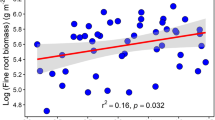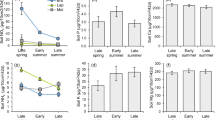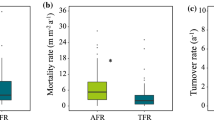Abstract
Fine roots play a pivotal role in terrestrial carbon and nutrient cycling. However, our knowledge on drivers of fine-root biomass (FRB) and productivity (FRP) focus on functional traits, biodiversity and abiotic factors, while less attention on allometric constraints, an indispensable driver of organism biomass allocation. We measured FRB (FRP) for 24 plots using 216 soil cores (ingrowth cores) from four forest types (birch, oak, larch and pine) on a warm-temperate mountain of north China, and investigated leaf, stem and fine-root functional traits, stand factors, diversity indices and soil property. We tested the allometric relationships among FRB, FRP, aboveground biomass (AGB), leaf biomass and functional traits, and examined how allometry, size-dependent growth strategy, the mass-ratio and complementarity effects affected FRB and FRP directly and indirectly. There was a stable allometric relationship between FRP and FRB at both the soil-core and plot levels, and the former supporting the predicted exponent for leaves (= 1) of the metabolic scaling theory. Contrary to common observations, both FRB and FRP at plot scale showed negative (or non-significant) relationships with aboveground (or leaf) biomass. Instead, higher AGB led to more conservative growth strategies, which led to lower FRB, and thus lower FRP due to allometric constraints. Root traits (mass-ratio effect) showed the strongest direct effect on FRB, while diversity index (complementarity effect) and soil fertility revealed relatively weak effects. FRP was strongly driven by allometry (FRB) and soil nitrogen, while functional traits and diversity index affected FRP via FRB instead of directly. The complementarity effect on FRP may be overestimated if FRP–FRB allometry was not considered in multivariate analyses. Our results are not conflict with the positive correlations of FRB (FRP) with AGB or leaf biomass reported by large-scale studies, but together suggest contrasting changes of growth strategies with tree size versus climate, which may affect aboveground–root relationship simultaneously. We also suggest to carefully test allometric relationships to better understand how complementarity versus mass-ratio effect, stand factors and environment, together affect fine-root dynamics.






Similar content being viewed by others
References
Barry KE, Mommer L, van Ruijven J, Wirth C, Wright AJ, Bai Y, Connolly J, De Deyn GB, de Kroon H, Isbell F, Milcu A, Roscher C, Scherer-Lorenzen M, Schmid B, Weigelt A (2019) The future of complementarity: disentangling causes from consequences. Trends Ecol Evol 34:167–180
Bergmann J, Weigelt A, van der Plas F, Laughlin DC, Kuyper TW, Guerrero-Ramirez N, Valverde-Barrantes OJ, Bruelheide H, Freschet GT, Iversen CM, Jens Kattge M, McCormack L, Meier IC, Rillig MC, Roumet C, Semchenko M, Sweeney CJ, van Ruijven J, York LM, Mommer L (2020) The fungal collaboration gradient dominates the root economics space in plants. Sci Adv 6(27):eaba3756.
Brown JH, Gillooly JF, Allen AP, Savage VM, West GB (2004) Toward a metabolic theory of ecology. Ecology 85:1771–1789
Brunner I, Godbold DL (2007) Tree roots in a changing world. J for Res 12:78–82
Chen C, Zhu J (1989) Handbook of main forest biomass in Northeast China. China Forestry Publishing House, Beijing
Chen G, Hobbie SE, Reich PB, Yang Y, Robinson D (2019) Allometry of fine roots in forest ecosystems. Ecol Lett 22:322–331
Deng Q, Yuan Z, Shi X, Lock TR, Kallenbach RL (2020) Testing allometric scaling relationships in plant roots. For Ecosyst 7:58
Du E, Terrer C, Pellegrini AFA, Ahlström A, van Lissa CJ, Zhao X, Xia N, Wu X, Jackson RB (2020) Global patterns of terrestrial nitrogen and phosphorus limitation. Nat Geosci 13:221–226
Duffy JE, Lefcheck JS, Stuart-Smith RD, Navarrete SA, Edgar GJ (2016) Biodiversity enhances reef fish biomass and resistance to climate change. Proc Natl Acad Sci 113:6230–6235
Enquist BJ, Niklas KJ (2002) Global allocation rules for patterns of biomass partitioning in seed plants. Science 295:1517–1520
Enquist BJ, West GB, Charnov EL, Brown JH (1999) Allometric scaling of production and life-history variation in vascular plants. Nature 401:907–911
Enquist BJ, Economo EP, Huxman TE, Allen AP, Ignace DD, Gillooly JF (2003) Scaling metabolism from organisms to ecosystems. Nature 423:639–642
Enquist BJ, Allen AP, Brown JH, Gillooly JF, Kerkhoff AJ, Niklas KJ, Price CA, West GB (2007) does the exception prove the rule? Nature 445(7127):E9–E10.
Fang J, Liu G, Zhu B, Wang X, Liu S (2006) Carbon cycle of three temperate forest ecosystems in Dongling Mountain in Beijing. Sci China Earth Sci 36:533–543 (in Chinese)
Farrar JF, Jones DL (2000) The control of carbon acquisition by roots. New Phytol 147:43–53
Finér L, Ohashi M, Noguchi K, Hirano Y (2011a) Factors causing variation in fine root biomass in forest ecosystems. For Ecol Manag 261:265–277
Finér L, Ohashi M, Noguchi K, Hirano Y (2011b) Fine root production and turnover in forest ecosystems in relation to stand and environmental characteristics. For Ecol Manag 262:2008–2023
Finér L, Domisch T, Dawud SM, Raulund-Rasmussen K, Vesterdal L, Bouriaud O, Bruelheide H, Jaroszewicz B, Selvi F, Valladares F (2017) Conifer proportion explains fine root biomass more than tree species diversity and site factors in major European forest types. For Ecol Manag 406:330–350
Förster A, Hertel D, Werner R, Leuschner C (2021) Belowground consequences of converting broadleaf to conifer forest: Comparing the fine root systems of European beech and Scots pine. For Ecol Manag 496:119457
Freschet GT, Pages L, Iversen CM, Comas LH, Rewald B, Roumet C, Klimesova J, Zadworny M, Poorter H, Postma JA, Adams TS, Bagniewska-Zadworna A, Bengough AG, Blancaflor EB, Brunner I, Cornelissen JHC, Garnier E, Gessler A, Hobbie SE, Meier IC, Mommer L, Picon-Cochard C, Rose L, Ryser P, Scherer-Lorenzen M, Soudzilovskaia NA, Stokes A, Sun T, Valverde-Barrantes OJ, Weemstra M, Weigelt A, Wurzburger N, York LM, Batterman SA, Gomes de Moraes M, Janecek S, Lambers H, Salmon V, Tharayil N, McCormack ML (2021) A starting guide to root ecology: strengthening ecological concepts and standardising root classification, sampling, processing and trait measurements. New Phytol 232:973–1122
Garnier E, Cortez J, Billès G, Navas M-L, Roumet C, Debussche M, Laurent G, Blanchard A, Aubry D, Bellmann A, Neill C, Toussaint J-P (2004) Plant functional markers capture ecosystem properties during secondary succession. Ecology 85(9):2630–2637.
Grime JP (1998) Benefits of plant diversity to ecosystems: immediate, filter and founder effects. J Ecol 86:902–910
Guo Z, Miao W, Lyu Y, Sun H, Fan D, Wang X (2023) Are fine roots ‘leaves underground’ in terms of allometry? A test in a tropical forest successional series in southwest China. Oikos. Special Issue:Root traits and functioning: from individual plants to ecosystems. e09465
He JS, Wang X, Flynn DF, Wang L, Schmid B, Fang J (2009) Taxonomic, phylogenetic, and environmental trade-offs between leaf productivity and persistence. Ecology 90:2779–2791
Hodge A (2004) The plastic plant: root responses to heterogeneous supplies of nutrients. New Phytol 162:9–24
Jackson RB, Canadell J, Ehleringer JR, Mooney HA, Sala OE, Schulze ED (1996) A global analysis of root distributions for terrestrial biomes. Oecologia 108:389–411
Jackson RB, Mooney HA, Schulze ED (1997) A global budget for fine root biomass, surface area, and nutrient contents. Proc Natl Acad Sci 94:7362–7366
Jacob A, Hertel D, Leuschner C (2013) On the significance of belowground overyielding in temperate mixed forests: separating species identity and species diversity effects. Oikos 122:463–473
Jin Y, Qian H (2022) V.PhyloMaker2: An updated and enlarged R package that can generate very large phylogenies for vascular plants. Plant Diver 44:335–339
Joswig JS, Wirth C, Schuman MC, Kattge J, Reu B, Wright IJ, Sippel SD, Ruger N, Richter R, Schaepman ME, van Bodegom PM, Cornelissen JHC, Diaz S, Hattingh WN, Kramer K, Lens F, Niinemets U, Reich PB, Reichstein M, Romermann C, Schrodt F, Anand M, Bahn M, Byun C, Campetella G, Cerabolini BEL, Craine JM, Gonzalez-Melo A, Gutierrez AG, He T, Higuchi P, Jactel H, Kraft NJB, Minden V, Onipchenko V, Penuelas J, Pillar VD, Sosinski E, Soudzilovskaia NA, Weiher E, Mahecha MD (2022) Climatic and soil factors explain the two-dimensional spectrum of global plant trait variation. Nat Ecol Evolut 6:36–50
Koch GW, Sillett SC, Jennings GM, Davis SD (2004) The limits to tree height. Nature 428:851–854
Kubisch P, Hertel D, Leuschner C (2015) Do ectomycorrhizal and arbuscular mycorrhizal temperate tree species systematically differ in root order-related fine root morphology and biomass? Front Plant Sci 6:64
Lai J, Zou Y, Zhang J, Peres-Neto PR (2022) Generalizing hierarchical and variation partitioning in multiple regression and canonical analyses using the rdacca.hp R package. Methods Ecol Evol 13:782–788
Laliberté E, Legendre P (2010) A distance-based framework for measuring functional diversity from multiple traits. Ecology 91:299–305
Lefcheck JS (2016) piecewiseSEM: Piecewise structural equation modeling in R for ecology, evolution, and systematics. Methods Ecol Evol 7:573–579
Lin Z, Fan D, Ma S, Miao W, Wang X (2022) Relative growth rate for trees at the growth stage is coordinated with leaf bulk modulus of elasticity and osmotic potential in a subtropical forest of China. Ecol Ind 141:109135
Ma Z, Guo D, Xu X, Lu M, Bardgett RD, Eissenstat DM, McCormack ML, Hedin LO (2018) Evolutionary history resolves global organization of root functional traits. Nature 555:94–97
Miao W, Ma S, Guo Z, Sun H, Wang X, Lyu Y, Wang X, Ma K (2022) Effects of biodiversity, stand factors and functional identity on biomass and productivity during the restoration of subtropical forests in Central China. J Plant Ecol 15:385–398
Milla R, Reich PB (2007) The scaling of leaf area and mass: the cost of light interception increases with leaf size. Proc R Soc B 274:2109–2114
Niklas KJ, Enquist BJ (2001) Invariant scaling relationships for interspecific plant biomass production rates and body size. Proc Natl Acad Sci 98:2922–2927
Niklas KJ, Cobb ED, Niinemets U, Reich PB, Sellin A, Shipley B, Wright IJ (2007) “Diminishing returns” in the scaling of functional leaf traits across and within species groups. Proc Natl Acad Sci 104:8891–8896
Pérez-Harguindeguy N, Díaz S, Garnier E, Lavorel S, Poorter H, Jaureguiberry P, Bret-Harte MS, Cornwell WK, Craine JM, Gurvich DE, Urcelay C, Veneklaas EJ, Reich PB, Poorter L, Wright IJ, Ray P, Enrico L, Pausas JG, de Vos AC, Buchmann N, Funes G, Quétier F, Hodgson JG, Thompson K, Morgan HD, ter Steege H, Sack L, Blonder B, Poschlod P, Vaieretti MV, Conti G, Staver AC, Aquino S, Cornelissen JHC (2013) New handbook for standardised measurement of plant functional traits worldwide. Aust J Bot 61:167–234
Price CA, Enquist BJ (2007) Scaling mass and morphology in leaves: an extension of the WBE model. Ecology 88:1132–1141
Reich PB (2014) The world-wide ‘fast-slow’ plant economics spectrum: a traits manifesto. J Ecol 102:275–301
Reich PB, Walters MB, Ellsworth DS (1997) From tropics to tundra: Global convergence in plant functioning. Proc Natl Acad Sci 94:13730–13734
Ryan MG, Phillips N, Bond BJ (2006) The hydraulic limitation hypothesis revisited. Plant Cell Environ 29:367–381
Sparks DL, Page AL, Helmke PA, Loeppert RH (2020) Methods of soil analysis part 3: chemical methods. Wiley, Hoboken
Sun Z, Liu X, Schmid B, Bruelheide H, Bu W, Ma K (2017) Positive effects of tree species richness on fine-root production in a subtropical forest in SE-China. J Plant Ecol 10:146–157
Sun H, Wang X, Fan D (2020) Effects of climate, biotic factors, and phylogeny on allometric relationships: testing the metabolic scaling theory in plantations and natural forests across China. For Ecosyst 7:51
Tang Z, Xu W, Zhou G, Bai Y, Li J, Tang X, Chen D, Liu Q, Ma W, Xiong G, He H, He N, Guo Y, Guo Q, Zhu J, Han W, Hu H, Fang J, Xie Z (2018) Patterns of plant carbon, nitrogen, and phosphorus concentration in relation to productivity in China’s terrestrial ecosystems. Proc Natl Acad Sci 115:4033–4038
Valverde-Barrantes OJ, Smemo KA, Feinstein LM, Kershner MW, Blackwood CB (2015) Aggregated and complementary: symmetric proliferation, overyielding, and mass effects explain fine-root biomass in soil patches in a diverse temperate deciduous forest landscape. New Phytol 205:731–742
van der Plas F (2019) Biodiversity and ecosystem functioning in naturally assembled communities. Biol Rev 94:1220–1245
van der Sande MT, Arets EJMM, Peña-Claros M, Hoosbeek MR, Cáceres-Siani Y, van der Hout P, Poorter L, Ostertag R (2017) Soil fertility and species traits, but not diversity, drive productivity and biomass stocks in a Guyanese tropical rainforest. Funct Ecol 32:461–474
Vanninen P, Makela A (1999) Fine root biomass of Scots pine stands differing in age and soil fertility in southern Finland. Tree Physiol 19:823–830
Wang X, Fang J, Tang Z, Zhu B (2006) Climatic control of primary forest structure and DBH–height allometry in Northeast China. For Ecol Manag 234:264–274
Wang X, Fang J, Zhu B (2008) Forest biomass and root–shoot allocation in northeast China. For Ecol Manag 255:4007–4020
Wang C, Chen Z, Brunner I, Zhang Z, Zhu X, Li J, Yin H, Guo W, Zhao T, Zheng X, Wang S, Geng Z, Shen S, Jin D, Li M-H (2018) Global patterns of dead fine root stocks in forest ecosystems. J Biogeogr 45:1378–1394
Weemstra M, Mommer L, Visser EJ, van Ruijven J, Kuyper TW, Mohren GM, Sterck FJ (2016) Towards a multidimensional root trait framework: a tree root review. New Phytol 211:1159–1169
Wright IJ, Reich PB, Westoby M, Ackerly DD, Baruch Z, Bongers F, Cavender-Bares J, Chapin T, Cornelissen JHC, Diemer M, Flexas J, Garnier E, Groom PK, Gulias J, Hikosaka K, Lamont BB, Lee T, Lee W, Lusk C, Midgley JJ, Navas M-L, Niinemets Ü, Oleksyn J, Osada N, Poorter H, Poot P, Prior L, Pyankov VI, Roumet C, Thomas SC, Tjoelker MG, Veneklaas EJ, Villar R (2004) The worldwide leaf economics spectrum. Nature 428:821–827
Yuan ZY, Chen HY (2012) A global analysis of fine root production as affected by soil nitrogen and phosphorus. Proc R Soc B 279:3796–3802
Zhang J, Xu B, Li M (2013) Vegetation patterns and species diversity along elevational and disturbance gradients in the Baihua Mountain Reserve, Beijing, China. Mt Res Dev 33:170–178
Zhao C, Lin Q, Tian D, Ji C, Shen H, Fan D, Wang X, Fang J (2023) Nitrogen addition promotes conservative resource-use strategies via aggravating phosphorus limitation of evergreen trees in subtropical forest. Sci Total Environ 889:164047
Zuur AF, Ieno EN, Elphick CS (2010) A protocol for data exploration to avoid common statistical problems. Methods Ecol Evol 1:3–14
Funding
This study was supported by the National Natural Science Foundation of China (#32271652), the Fang Jingyun ecological study studio of Yunnan province, and the Major Program for Basic Research Project of Yunnan Province (202101BC070002).
Author information
Authors and Affiliations
Contributions
Xiangping Wang designed the study; Wenhao Miao and Zijian Guo performed the experiment; Wenhao Miao, Zijian Guo, Yueming Lyu and Xuemei Wang collected the data; Wenhao Miao analyzed the data and wrote the original draft; Xiangping Wang and Wenhao Miao revised the manuscript. All authors contributed to the drafts and gave final approval for manuscript submission.
Corresponding author
Ethics declarations
Conflict of interest
The authors declare no competing interest.
Additional information
Communicated by Judy Simon.
Publisher's Note
Springer Nature remains neutral with regard to jurisdictional claims in published maps and institutional affiliations.
Supplementary Information
Below is the link to the electronic supplementary material.
Rights and permissions
Springer Nature or its licensor (e.g. a society or other partner) holds exclusive rights to this article under a publishing agreement with the author(s) or other rightsholder(s); author self-archiving of the accepted manuscript version of this article is solely governed by the terms of such publishing agreement and applicable law.
About this article
Cite this article
Miao, W., Guo, Z., Lyu, Y. et al. Size-dependent growth strategy and allometry, but not complementarity, as major drivers of fine-root biomass and productivity across warm-temperate forests. Eur J Forest Res (2024). https://doi.org/10.1007/s10342-024-01689-7
Received:
Revised:
Accepted:
Published:
DOI: https://doi.org/10.1007/s10342-024-01689-7




